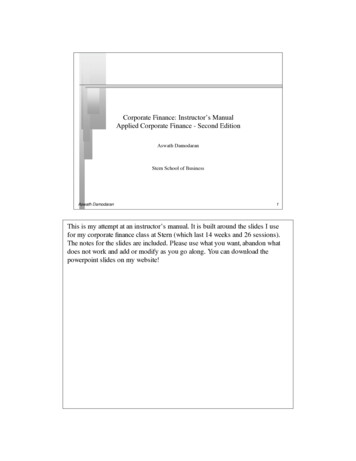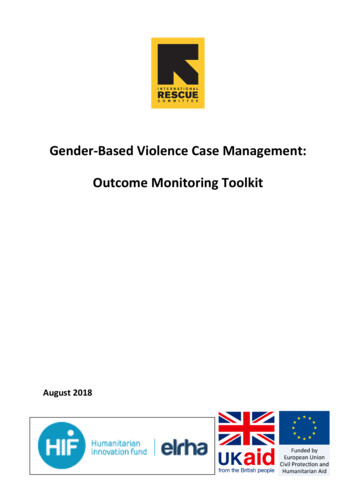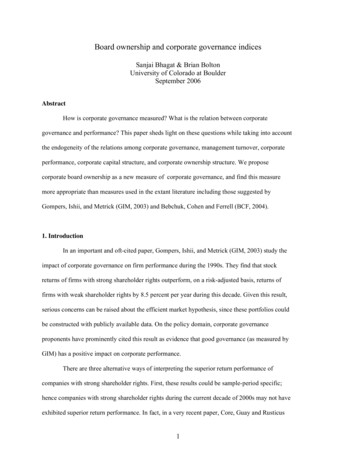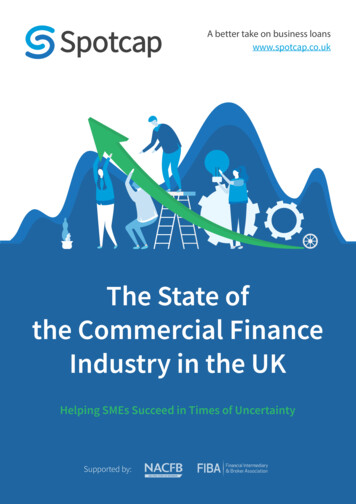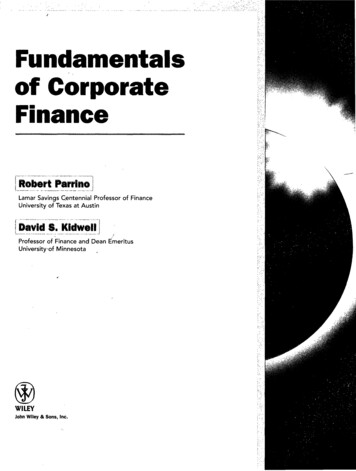
Transcription
Fundamentalsof CorporateFinanceLamar Savings Centennial Professor of FinanceUniversity of Texas at AustinDavid 8. KidwellProfessor of Finance and Dean EmeritusUniversityof MinnesotaWILEYJohn Wiley & Sons, Inc.
CONTENTSPart 1 IntroductionWhy Not Maximize Profits?CHAPTER 1THE FINANCIAL MANAGER AND THE FIRM1.1 The Role of the Financial ManagerStakeholders1222Building Intuition: The Riskiness of Cash Flows AffectsTheir Value13Can Management Decisions Affect Stock Prices?Three Fundamental Decisions inFinancial Management4Building Intuition: Sound Investments Are Those Wherethe Value of the Benefits Exceeds Their Costs6Building Intuition: Financing Decisions Affect the Valueof the Firm6/1.2 Forms of Business OrganizationSole Proprietorships13Building Intuition: The Financial Manager's Goal Is toMaximize the Value of the Firm's Stock14Building Intuition: Cash Flows Matter Mostto Investors4PartnershipsBuilding Intuition: The Timing of Cash Flows AffectsTheir Value12Maximize the Value of the Firm's StockIt's All about Cash Flows7141.5 Agency Conflicts: Separation of Ownership andControl15Ownership and ControlAgency Relationships1515Do Managers Really Want to Maximize Stock16Price?Aligning the Interests of Management andStockholders1677Corporations12Sarbanes-Oxley and Other Regulatory Reforms188Hybrid Forms of Business Organization91.6 The Importance of Ethics in BusinessBusiness Ethics1.3 Managing the Financial FunctionOrganization Structure10Types of Ethical Conflicts in Business11The Audit Committee21The Importance of an Ethical Business Culture11The Compliance and Ethics Director1.4 The Goal of the Firm20Are Business Ethics Different fromEveryday Ethics?209Positions Reporting to the CFOExternal Auditors9Serious Consequences22221112What Should Management Maximize?2012Summary of Learning Objectives Self-StudyProblems Solutions to Self-Study Problems Critical Thinking Questions Questions and Problems Sample Test Problems
XXIVIContentsPart 2 FoundationsJ„ . „CHAPTER 3CHAPTER 2THE FINANCIAL ENVIRONMENT ANDTHE LEVEL OF INTEREST RATES2.1 The Financial System2728The Financial System at WorkFINANCIAL STATEMENTS, CASH FLOWS, ANDTAXES3.1 Financial Statements and AccountingPrinciples5429Annual ReportsHow Funds Flow through the FinancialSystem3054Generally Accepted Accounting PrinciplesFundamental Accounting Principles2.2 Direct Financing31International GAAPA Direct Market Transaction313.2 The Balance SheetMoney and Capital Markets2.4 The Stock MarketNASDAQ37Equity61A More Informative Balance SheetA Market-Value Balance Sheet36The Income Statement372.5 Financial Institutions and IndirectFinancing383.5 Cash Flows38Corporations and the Financial System4071Additional Cash Flow Calculations3.7 Federal Income Tax417375Corporate Income Tax Rates4475Average versus Marginal Tax Rates4476Unequal Treatment of Dividends andInterest Payments77Cyclical and Long-Term Trends in InterestRates47Planning Ahead by Financial Managers703.6 Tying the Financial StatementsTogether732.6 The Determinants of Interest RateLevels41The Fisher Equation and Inflation6970The Statement of Cash Flows39Loan Contracts and Inflation66Net Income versus Cash FlowsFinancial Institutions and Their ServicesThe Real Rate of Interest65The Statement of Retained EarningsIndirect Market Transactions63633.4 The Income Statement and the Statement ofRetained Earnings6637"Stock Market Indexes603.3 Market Value versus Book Value36The New York Stock Exchange59Long-Term Assets and Liabilities35Futures and Options Markets5757Current Assets and Liabilities3335Public and Private Markets563133Primary and Secondary MarketsExchanges and Over-the-CounterMarkets345555Illustrative Company: Diaz ManufacturingInvestment Banks and Direct Financing2.3 Types of Financial Markets5348Summary of Learning Objectives Summary of KeyEquations Self-Study Problems Solutions to SelfStudy Problems Critical Thinking Questions Questions and Problems Sample Test ProblemsSummary of Learning Objectives Summary ofKey Equations * Self-Study Problems Solutions toSelf-Study Problems Critical Thinking Questions Questions and Problems Sample TestProblems
ContentsCHAPTER 4ANALYZING FINANCIAL STATEMENTS85The ROA Equation107The ROE Equation109The DuPont Equation110Applying the DuPont System4.1 Background for FinancialStatement Analysis864.5 Selecting a Benchmark87Trend Analysis4.2 Common-Size Financial StatementsCommon-Size Balance Sheets88112112Industry Analysis88113Peer Group AnalysisCommon-Size Income Statements113904.6 Using Financial Ratios4.3 Financial Statement Analysis91Why Ratios Are Better Measures91Short-Term Liquidity Ratios95Leverage Ratios99Profitability Ratios115Performance Analysis of DiazManufacturing115Limitations of Financial Statement Analysis92118Summary of Learning Objectives Summary of KeyEquations Self-Study Problems Solutions to SelfStudy Problems Critical Thinking Questions Questions and Problems Sample Test Problems102Market-Value Indicators11286Guidelines for Financial Statement AnalysisEfficiency Ratios110Is Maximizing ROE an Appropriate Goal?Perspectives on Financial Statement Analysisxxv106Concluding Comments on Ratios106ETHICS CASE:4.4 The DuPont System: A Diagnostic ToolAn Overview of the Du Pont System107Arthur AndersenA Sad Tale: The Demise of129107Part 3 Valuation of Future Cash Flows and RiskCHAPTER 55.3 Present Value and DiscountingTHE TIME VALUE OF MONEY1315.1 The Time Value of Money132Consuming Today or Tomorrow132Single-Period Investment148149Multiple-Period Investment149The Present Value Equation150Future and Present Value Equations Arethe Same151Building Intuition: The Value of Money Changes withTime133Applying the Present Value FormulaTime Lines as Aids to Problem SolvingThe Relations among Time, the Discount Rate, andPresent Value153Future Value versus Present ValueFinancial Calculator1341355.2 Future Value and CompoundingSingle-Period InvestmentTwo-Period InvestmentThe Future Value EquationThe Future Value Factor1331351555.4 Additional Concepts and Applications156The Rule of 72136Concluding Comments140140Building Intuition: Compounding Drives Much of theEarnings on Long-Term Investments142Calculator Tips for Future Value Problems146156157Compound Growth Rates137Applying the Future Value FormulaCalculator Tips for Present Value ProblemsFinding the Interest Rate135151158160Summary of Learning Objectives Summary ofKey Equations Self-Study Problems Solutions toSelf-Study Problems Critical Thinking Questions Questions and Problems Sample Test Problems
xxvijContentsCHAPTER 67.3 The Variance and Standard Deviation asMeasures of Risk216DISCOUNTED CASH FLOWSAND VALUATION6.1 Multiple Cash Flows167Calculating the Variance and StandardDeviation216Interpreting the Variance and StandardDeviation218168Future Value of Multiple Cash Flows168Present Value of Multiple Cash FlowsHistorical Market Performance1712217.4 Risk and Diversification6.2 Level Cash Flows: Annuities andPerpetuities175Present Value of an AnnuityFuture Value of an AnnuityPerpetuitiesSingle-Asset Portfolios175226Building Intuition: Diversified Portfolios areLess Risky232186The Limits of Diversification2321907.5 Systematic Risk6.3 Cash Flows That Grow at a ConstantRate192Growing Annuity233Building Intuition: Systematic Risk Isthe Risk That Matters234193Measuring Systematic Risk6.4 The Effective Annual Interest RateWhy the Confusion?233Why Systematic Risk Is All That Matters192Growing Perpetuity1942347.6 Compensation for Bearing Systematic RiskComparing Interest Rates194195The Appropriate Interest Rate Factor7.7 The Capital Asset Pricing ModelThe Security Market LineConsumer Protection Acts and InterestRate Disclosure197238239The Capital Asset Pricing Model andPortfolio Returns240197Summary of Learning Objectives Summary of KeyEquations Self-Study Problems Solutions to SelfStudy Problems Critical Thinking Questions Questions and Problems Sample Test ProblemsAppendix: Deriving the Formula for the PresentValue of an Ordinary Annuity206Summary of Learning Objectives Summary of KeyEquations Self-Study Problems Solutions to SelfStudy Problems Critical Thinking Questions Questions and Problems * Sample Test ProblemsCHAPTER 8BOND VALUATION AND THE STRUCTUREOF INTEREST RATES249207E T H I C S C A S E : Buy It on Credit and Be True toYour School2078.1 Capital Market Efficiency250Efficient Market Hypotheses8.2 Corporate BondsCHAPTER 7251252Market for Corporate BondsRISK AND RETURN209Bond Price Information252253Types of Corporate Bonds7.1 Risk and Return253211Building Intuition: More Risk Means a Higher ExpectedReturn 211,8.3 Bond Valuation254The Bond Valuation Formula255Calculator Tip: Bond Valuation Problems7.2 Quantitative Measures of ReturnHolding Period ReturnsExpected Returns237194Calculating the Effective Annual Interest RateProblem224Portfolios with More Than One Asset188Annuities Due224213211211Par, Premium, and Discount BondsSemiannual CompoundingZero Coupon Bonds260259257256
Contents8.4 Bond YieldsCommon and Preferred Stock262Yield'to MaturityEffective Annual YieldRealized Yield9.2 Common Stock ValuationA One-Period Model§,§ Interest Rate RiskA Perpetuity Model266Bond Theorem Applications269270Default Risk287288The Growth Stock Pricing Paradox2688,6 The Structure of Interest RatesMarketability287The General Dividend Valuation Model266Call Provision286263265Bond TheoremsZero-Growth Dividend Model291292Constant-Growth Dividend ModelThe Term Structure of Interest RatesComputing Future Stock Prices272293295The Relationship between R and gSummary of Learning Objectives Summary of KeyEquations Self-Study Problems Solutions to SelfStudy Problems Critical Thinking Questions Questions and Problems Sample Test ProblemsCHAPTER S2819,1 The Market for Stocks282282Secondary Markets and Their EfficiencyReading the Stock Market ListingsWM,297Mixed (Supernormal) Growth Dividend Model9.4 Valuing Preferred Stock297301Preferred Stock with a Fixed MaturityPerpetuity Preferred StockSTOCK VALUATION2909.3 Stock Valuation: Some SimplifyingAssumptions291269270Secondary Marketsxxvii286Preferred Stock: Debt or Equity?262j302303Summary of Learning Objectives Summary of KeyEquations Self-Study Problems Solutions to SelfStudy Problems Critical Thinking Questions Questions and Problems Sample Test ProblemsETHICS C A S E ! Insider Trading: Have I Got aStock Tip for You! 3 1 0283284Part 4 Capital Budgeting DecisionsCHAPTER i dFramework for Calculating NPVTHE FUNDAMENTALS OFCAPITAL BUDGETINGNet Present Value Techniques31210.1 An Introduction to Capital BudgetingThe Importance of Capital BudgetingThe Capital Budgeting ProcessSources of Information313313315316Building Intuition: Investment Decisions HaveOpportunity Costs31610.2 Net Present ValueNPV--The Basic ConceptNPV and Value Creation325326Computing the Payback PeriodEvaluating the Payback Rule32632832933010.4 The Accounting Rate of Return10.5 Internal Rate of ReturnCalculating the IRR317Valuation of Real Assets10.3 The Payback PeriodDiscounted Payback Period315Basic Capital Budgeting Terms321Concluding Comments on NPVHow the Payback Period Performs313Classification of Investment Projects319331331332When the IRR and NPV Methods Agree317317318When the NPV and IRR Methods DisagreeModified Internal Rate of Return (MIRR)IRR versus NPV: A Final Comment341334336340
xxviiijContents10.6 Capital Budgeting in Practice342Practitioners' Methods of Choice343Ongoing and Postaudit Reviews343CHAPTER 12EVALUATING PROJECT ECONOMICS AND CAPITALRATIONING396Summary of Learning Objectives Summary of KeyEquations Self-Study Problems Solutions toSelf-Study Problems Critical Thinking Questions Questions and Problems Sample Test ProblemsCost Structure and Sensitivity of EBITDA to RevenueChanges398Cost Structure and Sensitivity of EBIT to RevenueChanges401CHAPTER 1 1CASH FLOWS AND CAPITAL BUDGETING11.1 Calculating Project Cash Flows12.1 Variable Costs, Fixed Costs, andProject Risk397355356Building Intuition: High Fixed Costs Mean LargerFluctuations in Cash Flows and Profits40212.2 Calculating Operating Leverage405Building Intuition: Capital Budgeting is ForwardLooking356Degree of Pretax Cash Flow OperatingLeverage405Incremental After-Tax Free Cash FlowsDegree of Accounting Operating LeverageThe FCF Calculation357357Building Intuition: Incremental After-Tax Free CashFlows Are What Stockholders Care About358Cash Flows from OperationsCash Flows Associated with InvestmentsThe FCF Calculation: An ExampleFCF versus Accounting Earnings36036312.4 Risk Analysis364Five General Rules for Incremental After-Tax FreeCash Flow Calculations365Nominal versus Real Cash Flows . 368371Computing the Terminal- Year FCFExpected Cash Flows37437811.3 Forecasting Free Cash FlowsCash Flows from Operations410412Sensitivity AnalysisScenario AnalysisSimulation Analysis41341441512.5 Investment Decisions with CapitalRationing415Capital Rationing in a Single Period416379379418Summary of Learning Objectives Summary of KeyEquations Self-Study Problems Solutions to SelfStudy Problems Critical Thinking Questions Questions and Problems Sample Test Problems38011.4 Special Cases (Optional)Projects with Different LivesWhen to Harvest an Asset408Capital Rationing across Multiple PeriodsBuilding Intuition: We Discount Expected Cash Flowsin an NPV Analysis379Investment Cash Flows408Pretax Operating Cash Flow Break-EvenAccounting Break-Even36011.2 Estimating Cash Flows in PracticeTax Rates and DepreciationBuilding Intuition: Revenue Changes Drive ProfitVolatility Through Operating Leverage40812.3 Break-Even Analysis359406CHAPTER 13THE COST OF CAPITAL381381426384When to Replace an Existing AssetThe Cost of Using an Existing Asset385386Summary of Learning Objectives Summary of KeyEquations Self-Study Problems Solutions toSelf-Study Problems Critical Thinking Questions Questions and Problems Sample Test ProblemsETHICS C A S i : Doing the Right Thing: TheSchwan Food Company39413.1 The Firm's Overall Cost of CapitalThe Finance Balance Sheet427428Building Intuition: The Market Value of a Firm's AssetsEquals the Market Value of the Claims on ThoseAssets430How Firms Estimate Their Cost of CapitalBuilding Intuition: A Firm's Cost of CapitalIs a Weighted Average of All of ItsFinancing Costs432430
Contents13.2 The Cost of Debt43213.4 Using the WACC in PracticeKey Concepts for Estimating the Cost of Debt433Calculating WACC: An Example447Limitations of WACC as a Discount Rate forEvaluating Projects449Estimating the Current Cost of a Bond or anOutstanding Loan434Alternatives to Using WACC for EvaluatingProjects452435Estimating the Cost of Debt for a Firm13.3 The Cost of EquityCommon Stock439Preferred Stock445xxix447Building Intuition: The Current Cost of Long-Term DebtIs What Matters When Calculating WACC434Taxes and the Cost of DebtjSummary of Learning Objectives Summary of KeyEquations Self-Study Problems Solutions toSelf-Study Problems Critical Thinking Questions Questions and Problems Sample Test Problems436438Part 5 Working Capital Management and Financing Decisions14.7 Financing Working CapitalCHAPTER 14461WORKING CAPITAL MANAGEMENT479Strategies for Financing Working Capital479Financing Working Capital in Practice14.1 Working Capital BasicsSources of Short-Term Financing462Working Capital Terms and Concepts462Working Capital Accounts andTrade-Offs464;481481Summary of Learning Objectives Summary of KeyEquations Self-Study Problems Solutions toSelf-Study Problems Critical Thinking Questions Questions and Problems Sample Test Problems14.2 The Operating and Cash ConversionCycles465Operating Cycle467Cash Conversion CycleCHAPTER I SHOW FIRMS RAISE CAPITAL46814.3 Working Capital InvestmentStrategies47015.1 Bootstrapping493494How New Businesses Get StartedFlexible Current Asset InvestmentStrategy471Initial Funding of the Firm494495Restrictive Current Asset InvestmentStrategy15.2 Venture Capital471The Working Capital Trade-Off495The Venture Capital Industry471496Why Venture Capital Funding Is Different14.4 Accounts ReceivableTerms of Sale472The Venture Capital Funding Cycle472Aging Accounts ReceivableEconomic Order Quantity47447514.6 Cash Management and BudgetingCash Collection477500475Just-in-Time Inventory ManagementReasons for Holding Cash497Venture Capitalists Provide More ThanFinancing499The Cost of Venture Capital Funding14.5 Inventory Management49647715.3 Initial Public Offering477477501Advantages and Disadvantages of GoingPublic501Building Intuition: Investors View Seasoned Securitiesas Less Risky Than Unseasoned Securities502Investment Banking Services502
ContentsXXXOriginationUnderwritingDistributionThe Proceeds503Building Intuition: People Behave Differently toward aFirm in Financial Distress, and This IncreasesBankruptcy Costs54750350550516.3 Two Theories of Capital Structure1.4 IPO Pricing and CostThe Trade-Off Theory507The Underpricing DebateIPOs Are Consistently UnderpricedThe Cost of an IPO5075095125135.6 Private Markets and Bank LoansPrivate Equity FirmsSummary of Learning Objectives Summary of KeyEquations Self-Study Problems Solutions to SelfStudy Problems Critical Thinking Questions Questions and Problems Sample Test Problems511The Cost of a General Cash OfferPrivate Placements514CHAPTER515If561DIVIDENDS AND DIVIDEND POLICY515516Private Investments in Public EquityCommercial Bank Lending1 7 . 1 Dividends517562Building Intuition: Dividends Reduce theStockholders' Investment in a Firm563518Concluding Comments on Fundingthe Firm55116.4 Practical Considerations in Choosing a CapitalStructure553Competitive or Negotiated SalePrivate versus Public Markets551The Empirical Evidence5.5 General Cash Offer by a PublicCompany511Shelf Registration550The Pecking Order Theory507550Types of Dividends520563The Dividend Payment ProcessSummary of Learning Objectives Summary of KeyEquations Self-Study Problems Solutions toSelf-Study Problems Critical Thinking Questions Questions and Problems Sample Test Problems564Building Intuition: Dividend Announcements SendSignals to Investors56517.2 Stock Repurchases568How Stock Repurchases Differ from DividendsETHICS CASES Profiting from Death:"Janitor's Insurance"524How Stock Is Repurchased56917.3 Dividend Policy and Firm ValueC H ApTERBenefits and Costs of Dividends1 6526CAPITAL STRUCTURE POLICY571572Stock Price Reactions to DividendAnnouncements574Dividends versus Stock Repurchases1,1 Capital Structure and Firm ValueThe Optimal Capital Structure17.4 Stock Dividends and Stock Splits527The Modigliani and Miller PropositionsBuilding Intuition: The Cost of Equity Increases WithFinancial Leverage5331,1 The Benefits and Costs of Using DebtThe Costs of Debt544Stock DividendsStock Splits577577578Reasons for Stock Dividends and Splits578528Building Intuition: Capital Structure Does Not AffectFirm Value If It Does Not Affect Total Cash Flowsto Securityholders529537575527Building Intuition: The Optimal Capital StructureMinimizes the Cost of Financing a Firm'sActivities528The Benefits of Debt56853717.5 Setting a Dividend PolicyWhat Managers Tell Us579579Practical Considerations in Setting aDividend Policy580Summary of Learning Objectives Self-Study Problems Solutions to Self-Study Problems Critical ThinkingQuestions Questions and Problems Sample TestProblems
ContentsXXXIPart 6 Business Formation, Valuation, and Financial PlanningCHAPTER 18BUSINESS FORMATION, GROWTH,AND VALUATIONCHAPTER 19FINANCIAL PLANNING AND FORECASTING19.1 Financial Planning18.1 Starting a Business587588Choosing the Right Organizational FormFinancial Considerations628The Planning DocumentsMaking the Decision to Proceed628Building Intuition: A Firm's Strategy Drives ItsBusiness Decisions629588591Concluding Comments18.2 The Role of the Business Plan596The Key Elements of a Business Plan63119.2 Financial Planning Models596Why Business Plans Are ImportantThe Sales Forecast597631631Building a Financial Planning ModelA Simple Planning Model18.3 Valuing a Business632634598Fundamental Business Valuation Principles59819.3 A Better Financial Planning ModelBuilding Intuition: The Value of a Business Is Specificto a Point in Time598The Blackwell Sales CompanyBuilding Intuition: The Value of a Business Is Not theSame to All Investors599The Balance SheetBusiness Valuation Approaches59918.4 Important Issues in ValuationPublic versus Private CompaniesThe Income Statement613638638The Preliminary Pro Forma Balance SheetImproving Financial Planning Models19.5 Managing and Financing GrowthControlling Interest versus MinorityInterest615External Funding NeededThe Internal Growth RateSummary of Learning Objectives Summary of KeyEquations Self-Study Problems Solutions to SelfStudy Problems Critical Thinking Questions Questions and Problems Sample Test ProblemsE T H I C S C A S E : The Subprime Mortgage624Growth As a Planning Goal644647650651The Sustainable Growth RateGrowth Rates and Profits644647A Graphical View of Growth61664164319.4 Beyond the Basic Planning Models613Market Meltdown: How Did It Happen?637637The Final Pro Forma Balance SheetYoung (Rapidly Growing) versus MatureCompanies614Key People627586652654654Summary of Learning Objectives * Summary of KeyEquations Self-Study Problems Solutions to SelfStudy Problems Critical Thinking Questions Questions and Problems Sample Test ProblemsPart 7 Options in Corporate Finance and International DecisionsCHAPTER 2 0OPTIONS AND CORPORATE FINANCE20.1 Financial OptionsCall Options665Put Options667664Building Intuition: Payoff Functions for Options AreNot Linear668665American, European, and Bermudan OptionsMore on the Shapes of Option PayoffFunctions66820.2 Option Valuation669Limits on Option Values668669Variables That Affect Option Values671
XXXIIContentsThe Binomial Option Pricing Model673Factors Affecting International FinancialManagement695Put-Call Parity ' 676Goals of International Financial Management20.3 Real Options677Basic Principles Remain the SameOptions to Defer Investment677Options to Make Follow-On InvestmentsOptions to Change OperationsOptions to Abandon Projects67821.2 Foreign Exchange Markets679699Market Structure and Major ParticipantsForeign Exchange RatesAgency Costs of EquityForeign Currency Quotations70270368121.3 International Capital Budgeting683Determining Cash Flows20.5 Options and Risk Management684Exchange Rate RiskSummary of Learning Objectives Summary of KeyEquations Self-Study Problems Solutions to SelfStudy Problems Critical Thinking Questions Questions and Problems Sample Test ProblemsCountry RiskEnough?C A S E : Compensation—How Much Is691 ,708709The Barcelona Example71121.4 Global Money and Capital MarketsThe Eurocurrency MarketThe Eurocredit MarketINTERNATIONAL FINANCIAL MANAGEMENT69321.5 International BankingGlobalization of the World EconomyThe Rise of Multinational Corporations713714714716Risks Involved in International Bank LendingEurocredit Bank Loans21.1 Introduction to International FinanceManagement694713713International Bond MarketsCHAPTER 2 1708709The Emergence of the EuromarketsETHICS700700The Equilibrium Exchange Rate681Agency Costs of Debt698Building Intuition: The Basic Principles of FinanceApply No Matter Where You Do Business 698678Concluding Comments on NPV Analysis and RealOptions 68020.4 Agency Costs698716718Summary of Learning Objectives Summary of Key694695Equations Self-Study Problems Solutions to SelfStudy Problems Critical Thinking Questions Questions and Problems Sample Test Problems
THE FINANCIAL MANAGER AND THE FIRM 1 1.1 The Role of the Financial Manager 2 Stakeholders 2 It's All about Cash Flows 2 Building Intuition: Cash Flows Matter Most . The Bond Valuation Formula 255 Calculator Tip: Bond Valuation Problems 256 Par, Premium, and Discount Bonds 257 Semiannual Compounding 259 Zero Coupon Bonds 260.




